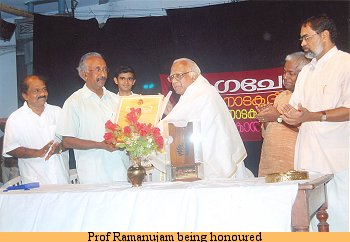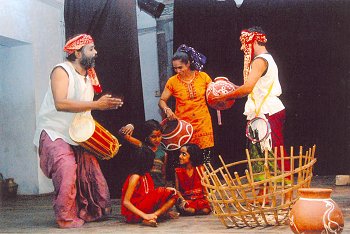
The story
of Kalankari
- Padma Jayaraj,
Thrissur
e-mail: padmajayaraj@gmail.com
April 6, 2008
 Renga
Chetana, an established a theater group in Thrissur, Kerala, celebrated
the World Theater Day (March 27) by honoring the veteran drama director
Prof. Ramanujam. Men, who stand tall in the field of theater in Kerala,
spoke on the occasion. A trilogy written by Arun Poothezhath, was launched. Renga
Chetana, an established a theater group in Thrissur, Kerala, celebrated
the World Theater Day (March 27) by honoring the veteran drama director
Prof. Ramanujam. Men, who stand tall in the field of theater in Kerala,
spoke on the occasion. A trilogy written by Arun Poothezhath, was launched.
Kala-padasala
based in the sleepy village of Arangottukara, staged 'The story of Kalankari.'
Theater buffs sat late into night watching the play measured its appeal.
A simple theme unfolded its complexities in poetic dimensions.
Cast in the
mode of the old sangeetha nritha natakam, the play revived memories
of a genre lost in the world of experiments. Essentially folk in its presentation,
the theme takes us back to the origin of settled life, the beginning of
civilizations.
The stage
setting
People watched
the stage being set in front of them. A stout bamboo pole with spikes stands
in the middle, in front is a potter's wheel; at the back an abstract form
of a plant carrying three flowers. Soon we realize that this is the home
of a woman with its central pillar, that the flowers are decorated pots
made by her, a pot maker, put out in the sun to dry. A group of children,
men, and women come singing and dancing narrating the story of a woman
who made pots and pans and of her man who went around selling them.
The folk numbers,
a mixture of kurava and gypsy style, and the narration of the mythical
origin of human story lend depth to the drama.
The play
 When
the chorus departs, the scenes reveal the joy of young life and love, the
joy of hard labor, and of domestic bliss in a rural ambience. But tragedy
is embedded in human lot. He dies and his young widow is left inconsolable.
The chorus is the village folk now enacting the roles of a neighborhood.
The typical village scene showcases the social milieu, its complexity in
their sympathy and in their naive gossip. Lighting a lamp under the pillar,
the sanctum sanctorum of her home, she keeps vigil in tears. When
the chorus departs, the scenes reveal the joy of young life and love, the
joy of hard labor, and of domestic bliss in a rural ambience. But tragedy
is embedded in human lot. He dies and his young widow is left inconsolable.
The chorus is the village folk now enacting the roles of a neighborhood.
The typical village scene showcases the social milieu, its complexity in
their sympathy and in their naive gossip. Lighting a lamp under the pillar,
the sanctum sanctorum of her home, she keeps vigil in tears.
Sun rise and
set; time moves on; seasons change; nature is in havoc. Natural urges wake
up in the hearts of people; spring explodes in the mind of the young widow.
Torn between grief and longing, torn by tradition and superstition, the
young woman dreams of life. Life for her is creative joy in working with
hands.
The dream
technique used is a masterstroke to explore the psychological realities
that lurk within. The flower-seller is a figment of her imagination. The
dialogue between Kalankari and the flower seller is between her hopes and
fears. Allegorically, the flower-seller is spring. She brings colors on
the stage, scattering flowers everywhere, the chorus feel her presence
communicating the spirit of Spring to the audience.
Like the flower
girl, the ghost and the strange robber too descend down the central pole
into her life. Tired of conflict, she is taken to the verge of martyrdom,
SATI, by the ghost of her dead husband. The chorus intervenes to
tell the finale of an Indian widow. But a child poses a question in all
innocence to the traditional ending of ever after... it reminds you of
the child who dared to shout "the Emperor is naked." The innocent query
sets the village folk to scratch their heads.
The robber
and the flower girl play the game of hide and seek in beautiful dance steps.
And finally the robber with his strange philosophy of 'giving for taking'
wins the debate in the mind of Kalankari. He tells her to make things other
than pots and pans. And like the flower girl, he gives her colors to paint
the toys: birds, animals, humans in myriad forms and variegated colors.
Both the Kalankari
and the village folk wake up to a different reality: understand the need
to go on, the need to be positive, to be creative.
Technique
of presentation
Story-telling
method, folk aspects heavily drawing from porattu natakam, and kurathy,
and the role of children are the striking features.
Pookari and
robber are regular characters of porattu natakam, the indigenous
theatre of Kerala. The play moves back and forth from the physical to the
mental plane with extraordinary ease. Even when the flower girl and
the robber do not interact with the villagers, they perfectly merge into
the medley of the village community - a master stroke of direction.
Songs by Sreeja,
the author of the text, and by the poet PP Ramachandran and the mode of
singing in the vein of natan pattukal add to the mores of Kerala.
Rajitha as
Kalankari, Beena as pookkari, Dinesan as the ghost, and Prasanth
as the robber, make the play a success.
CN Narayanan
deserves credit for direction. The play has an earthy vitality. With the
Earth's first clay, the potter's wheel becomes the symbol of creation;
the earthen bowl the secret well of life; the woman an extension of creativity
filled with love, longing and natural urges. The drama, in spite of its
limitation as a folk presentation, is truly poetic in dimension. Even when
the theme is woman-centered in a patriarchal society, the director pins
all hopes on positive elements in society to bring about a change in perspective,
in a wholesome approach.
Padma
Jayaraj is a regular contributor to www.narthaki.com
|

